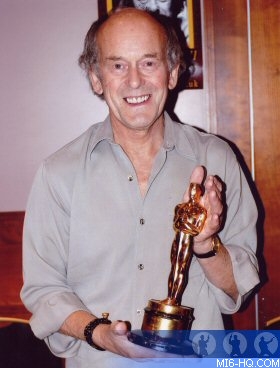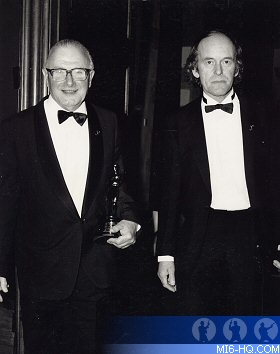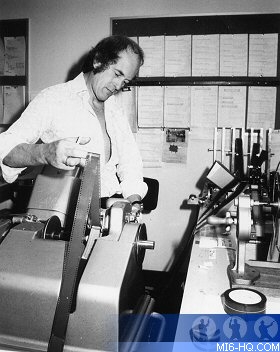 |
| |
MI6 caught up with Academy Award winner Norman Wanstall
to talk about his career as an editor and his
work on the James Bond series...
|
|
Norman Wanstall Interview (1)
7th February 2008
How did you get started in the film
industry - had you held many jobs before entering the
movie business?
In 1949 I was a 14-year-old schoolboy, and I had a friend
whose mother was the assistant to the Production Controller
at Pinewood film studios. During the school holidays she
invited a group of us to visit the studio and I was absolutely
captivated by what I saw. The highlight of the day was being
allowed onto one of the stages and watching Alan Ladd rehearsing
a scene for the film ‘Hell Below Zero’. The set
was the cabin of a ship and it looked totally realistic,
but of course when we looked around at the back it was all
made up of plywood and scaffold poles. The whole thing was
make-believe and we loved it. It was a magical day and the
memory of it stayed with me right through my schooldays.
After leaving school I spent two years doing my National
Service, and when I returned to civilian life I contacted
the lady at Pinewood and fortunately she remembered me.
She invited me to the studio for a chat, and soon afterwards
offered me a job as a trainee film editor.
|
|

Above: Norman Wanstall with his Academy
Award for Sound Editing for Goldfinger |
I jumped at the chance to work in the industry although at the
time I had no idea what a film editor’s function was. I
was put under contract for three years and by the end of that
term I had moved up the promotion ladder and was the assistant
to one of the sound-track editors (known as dubbing editors.)
I should point out that in those days (and for many years afterwards)
film studios were basically factories. All the producers, directors,
technicians, plasterers, carpenters, electricians and office
staff were all permanently employed under contract, including
some of the leading actors, and everyone turned up for work every
day and went from one film to another. There were of course people
who had left the studio system to work freelance, and they would
invariably work in the studios on films brought in from abroad,
or on independent films brought in from outside. It has been
said that the studio system suffered from bureaucracy and therefore
there wasn’t much scope for innovation and experimentation,
but many fine films were made under the studio system and only
after a technician had received a thorough training were they
ever considered for promotion.
Probably the most accomplished and famous dubbing
editor at that time was Winston Ryder, who had worked on numerous
major
movies including such prestigious tiles as Lawrence Of Arabia
and Bridge On The River Kwai. Just as my 3-year contract at Pinewood
was coming to an end it became known that Ryder was looking for
a new assistant, and
my colleagues at the studio suggested I would be the best man
for the job. I subsequently left to go freelance and worked with
Ryder on three major productions, the last of which was Sink
the Bismarck edited by Peter Hunt.
How did you get involved with Bond and who did you work
most closely with on those productions?
In spite of working extensively on the sound-track side of
editing my ambition was not to become a dubbing editor but a film
editor, so I asked Peter Hunt if he would consider me for a job
as his assistant so that I could return to working with picture
again. He took me on and we formed a good working relationship,
and after four pictures together Peter was given Dr No to edit.
The rest, of course, is history! The budget on Dr No was such
that the production could not afford the two dubbing editors required
for such a busy sound-track (one for dialogue and one for sound
effects) so Peter promoted me to sound-effects editor and I continued
in that role for the next four Bond pictures.
Even though Peter and I were still very much a team, I was left
alone most of the time to concentrate on the assembling and creating
of the sound-effects. As soon as shooting was completed I worked
closely with the production sound recordist, going out with his
crew to record the cars, motor-cycles, helicopters, autogyro
etc. After that I teamed up with the studio sound mixer (Gordon
McCullum), and together we created at an early stage many of
the more complex sounds that involved mixing various components
together.

Above: "This is one of
my favourite pictures taken with the great Gordon McCullum
who was the chief dubbing mixer on the first Bond movies.
He and I worked very closely together creating the specialised
sound effects, such as the electronic sliding doors, Oddjob’s
flying hat and Dr No crushing the metal idol in his clawed
hand. He was a very difficult man to work with but he loved
the Bond movies and couldn’t wait for me to take
tracks into his theatre for him to blend together." |
|
You've had a spell as both an editor
and a soundtrack editor, can you describe the responsibilities
of both, how they compare, and which task do you prefer?
Even though I had a fair amount of success as a dubbing
editor my sole ambition was to become a film editor. The film
editor has so much more influence on the final outcome of the
picture. Usually he comes onto the payroll prior to shooting
and would discuss with the director any concerns he has about
the script. If, during shooting he feels extra shots would
enhance a scene, he would inform the director and if time allowed
the director would shoot them.
From then on the editor is left
alone to put the film together the way the director envisaged,
and once the film is finally assembled (usually a week or
two after the completion of shooting) he and the director
will
discuss each scene and decide where the film could be improved
by making changes or trying new ideas.
You have to remember
that because scenes are often shot from beginning to end
from many different camera angles, the director on a
major feature
film such as a James Bond would shoot hundreds of thousands
of feet of film. The final film that’s shown in the cinema
would only be around thirteen thousand feet long, so you have
some idea of the editor’s job in creating the best possible
movie out of so much material. |
You can see from the above that the director relies very much
on the skill of the editor to get the best out of his material,
and the editor has the satisfaction of knowing that the final
look and pace of the film is very much his responsibility. It’s
a fantastic job and commands a lot of respect from the rest of
the crew, and I know that on all my film editing jobs I was able
to contribute ideas and make my mark in some way. I must say
I was very fortunate during the time I was working as Peter Hunt’s
assistant, because he was only really interested in ‘fine
cutting’ scenes where every cut had to be timed to perfection.
He found the job of roughly assembling the scenes rather tedious,
so he frequently let me put scenes together and then he would
take over later to do the serious work. This gave me a lot of
editing practice at an early stage so I was well prepared when
my big break as a film editor finally arrived.
As regards the job of the soundtrack editor,
I’ve realised over the years that people outside
the industry do not understand that the picture and sound
are totally separate throughout the making of a film, so
they cannot easily comprehend what the job involves. Perhaps
it would be helpful if I briefly explain the way a film
is processed...
The first thing to remember is that the camera and sound
crews are totally separate during shooting, and at times
the sound recordist will be on the opposite side of the
set to the camera. They are linked electronically for synchronisation
but otherwise they work independently. At the end of each
day’s shooting, the negative taken
from the camera is sent to the laboratories and the tape
from the sound recorder is sent to the sound department.
The following day the positive picture comes back from the
labs, and the sound-track comes back from the sound department
transferred onto 35mm stock. The cutting-room staff then
synchronise the two, and every roll is stored away in two
cans, one sound and one picture.
|
|

Above: Norman Wanstall in the cutting
room |
By the
time the editor has made his first assembly of the picture (known
as the rough cut) there would be about 13 or 14 cans of film
and the same number of cans of sound. The dubbing editor is able
to assess each reel of sound in turn and decide which sections
of the track can be used in the final
film. In major action films such as the Bond movies, a very large
percentage of the track has to be discarded and re-created from
scratch.
This involves re-recording all the different elements and mixing
them back together again, so even a simple scene of two people
talking as they walk along a street would involve replacing the
dialogue, the sound of their footsteps and movements, the exterior
atmospheres and the sound made by any other items that appear
in the scene. One could easily end up with six to ten tracks
for that one scene alone so you can imagine what is involved
in replacing a battle scene or a car chase. The Bond's were a
lot of work for me because all the boats, trains, planes, cars,
motor-cycles, helicopters, autogiros, gadgets and underwater
sounds etc. had to be re-recorded and replaced from scratch.
Also I had to invent sounds for special-effects scenes such as
the laser beam, Oddjob’s flying hat and the atomic machine
in Dr No’s laboratory. Yet again of course many of the
actors used in the early Bond's such as Ursula Andress and Gert
Frobe were foreigners with strong accents, so they had to be
re-voiced and all the scenes they were involved in had the sound
replaced.
I must say that as a sound-track editor I was
very fortunate to have the Bond's to work on because at least
I could make a
genuine creative contribution at times, but generally the job
is relatively routine and cannot compare with the close involvement
of the film editor.
Which have been your most memorable production thus far?
The
film I worked on that I call my favourite was without doubt Ipcress
File on which I worked as sound-track editor, but my
most memorable film has to be the first film I edited which was
called Joanna. Whilst working on the Bond's I was contacted by
a popular singer/actor/writer called Mike Sarne, who had shot
a short film called Road to St Tropez but hadn’t been able
to afford a sound crew. I liked the guy so much I put a track
on the film for him free of charge, and as a result we became
close friends.
Some time later he was given the chance by 20th Century Fox
to direct his own script (Joanna) and he rewarded me by giving
me the chance to edit it. It was a swinging sixties story and
was unfortunately panned by the critics, but with Mike’s encouragement I’d
applied a very stylised type of editing which was rare in those
days and it got me noticed. The critics picked up on it and other
directors became interested and even the great Norman Jewison
flew me back from Denmark for an interview and short-listed me
for Fiddler On The Roof. Without doubt Joanna was my most memorable
project because it was a huge stepping stone in my career and
enabled me to follow
my ambition of becoming a respected film editor.
Related Articles
 Norman
Wanstall Interview (3)
Norman
Wanstall Interview (3)
 Norman
Wanstall Interview (2)
Norman
Wanstall Interview (2)
 Bond
Music Articles
Bond
Music Articles
Many thanks to Norman Wanstall. All pictures courtesy Norman
Wanstall.